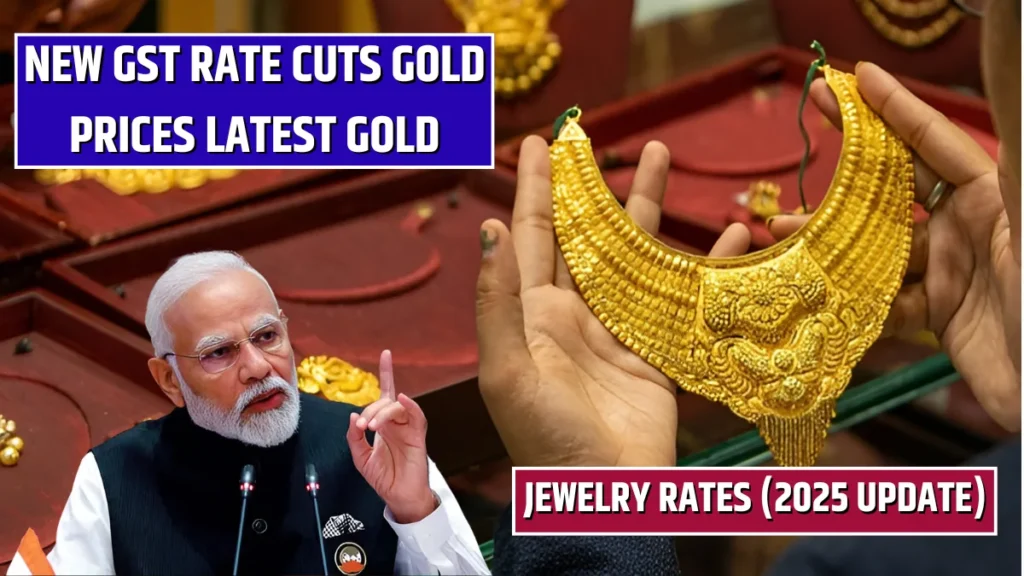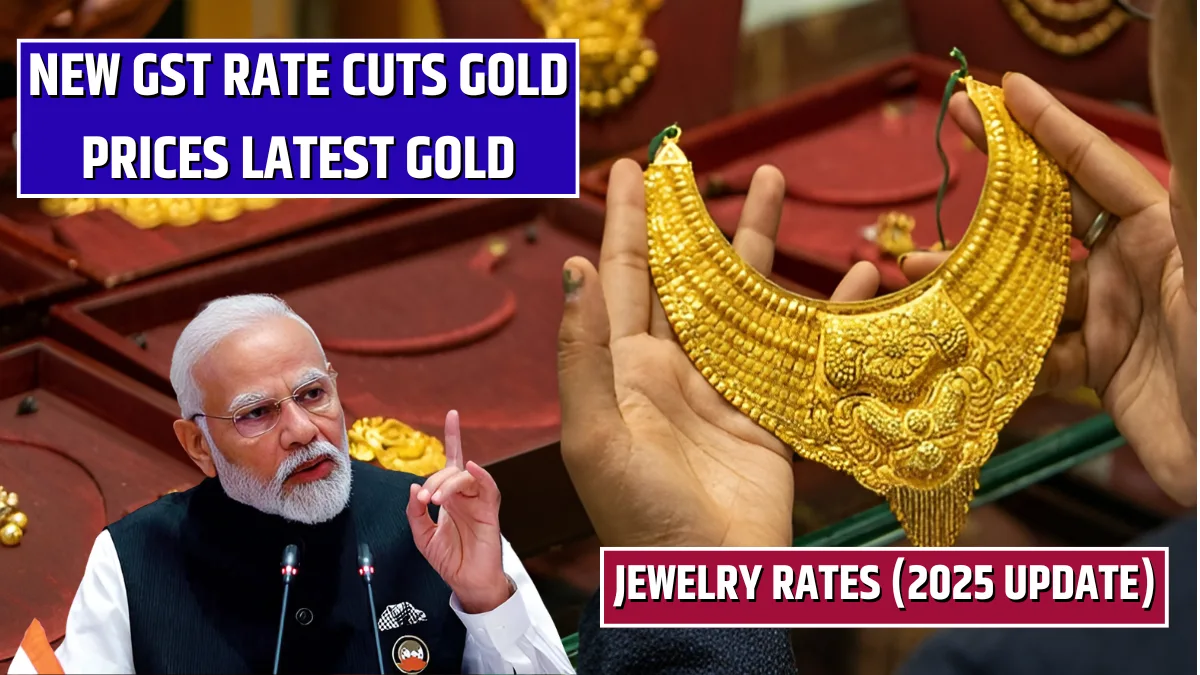New GST Rate Cuts Gold Prices – The precious metals market in India has always been an area of great interest to investors, collectors, and consumers alike. Gold, silver, and jewelry hold both cultural and economic significance, often reflecting broader trends in global economics and local policies.
One of the most recent shifts that has made a significant impact on the market is the reduction of Goods and Services Tax (GST) rates on gold and silver. This change, which came into effect in 2025, has already started to influence the prices of these precious metals and jewelry. As we move further into the year, the implications of these cuts are becoming clearer.

Understanding the GST Rate Cuts on Precious Metals
In 2025, the Indian government announced a reduction in the GST rates on gold and silver from 3% to 2.5%. While this might seem like a small change, it has already started to make waves in the pricing of these metals. The reduction is part of a broader initiative to make these valuable assets more accessible to consumers and encourage legal trade. The government hopes this move will not only ease the financial burden on consumers but also help reduce illegal smuggling of precious metals.
Before this change, the higher GST rate on gold and silver was one of the factors contributing to their inflated prices in India. By reducing the tax burden on these commodities, the government is hoping to bring down prices slightly, making gold and silver more affordable to a wider range of buyers. While global market trends still play a significant role in determining gold and silver prices, the local tax cut is a noteworthy change that has begun to affect the market.
The Impact on Gold Prices in 2025
Gold has always been a preferred investment choice, particularly in India, where it holds cultural significance and is often viewed as a hedge against inflation. The reduction in the GST rate has had an immediate effect on the price of gold, which has seen a noticeable decrease since the cut was announced. The drop in price can be attributed directly to the lowered tax rate, which has made it cheaper for consumers to buy gold.
As of early 2025, the price of 24-carat gold has fallen by about 2-3% in India. This price decrease is relatively modest, but it has already made a difference in the purchasing decisions of many buyers. For those looking to invest in gold or purchase gold jewelry, this reduction in price has come as a welcome relief. Gold, traditionally seen as a safe haven in times of economic uncertainty, remains a highly sought-after commodity. The lower GST rate makes it a more attractive option for those looking to diversify their portfolios or protect their savings against inflation.
In addition to making gold more affordable, the reduction in GST has also encouraged a sense of confidence among buyers. As the price of gold stabilizes, more individuals are likely to consider it as a long-term investment. However, it’s important to note that while the tax reduction has brought down local prices, global factors such as interest rates, inflation, and geopolitical events will continue to play a significant role in determining the overall cost of gold in the future.
The Effect on Silver Prices
Silver, while generally more affordable than gold, has also been impacted by the reduced GST rates. Silver is often viewed as a more accessible option for investors who are not ready to make the larger financial commitment that gold requires. Although silver prices are typically more volatile than gold, the reduction in the GST rate has made it cheaper for consumers to purchase silver in India.
Since the GST rate cut, silver prices have dropped by around 2-2.5%. While this reduction is smaller compared to gold, it still represents a significant shift in the market. For many buyers, silver presents a lower-cost entry point into the precious metals market, and the recent price drop has sparked renewed interest in investing in silver. The reduced GST rates make silver more affordable and accessible, which could encourage more people to purchase it, either as a store of value or for use in jewelry.
The affordability of silver also makes it an attractive option for those who may not have the financial means to purchase gold. This has the potential to drive demand for silver in both the investment and consumer markets. As the demand for silver rises, the market could see more fluctuations in silver prices, which will be influenced by both domestic and international factors.
Jewelry Prices: The Ripple Effect
The reduction in GST rates has had a particularly noticeable impact on the jewelry market. In India, where gold jewelry holds immense cultural value, the lower tax rates have made gold jewelry more affordable. This price drop has already begun to have an effect on consumer behavior, with many individuals choosing to purchase gold jewelry that they might have otherwise considered too expensive.
For jewelers, the reduced GST rate means they can offer more competitive prices on gold and silver jewelry. A piece of gold jewelry that would have cost INR 50,000 before the rate cut may now cost INR 48,000 or slightly less, depending on the weight and design of the item. This reduction in price, though modest, has the potential to increase consumer interest and spark a rise in sales. As more people feel that they are getting better value for their money, jewelers are likely to see a boost in both the volume of sales and customer confidence.
Moreover, the reduced tax burden on jewelry purchases is expected to foster greater transparency in the market. As prices become more predictable, consumers are more likely to buy jewelry from trusted and licensed dealers. This, in turn, could lead to a reduction in the informal or illegal gold trade, which has long been a concern in the industry.
The Long-Term Outlook for Gold, Silver, and Jewelry Prices
While the immediate effects of the GST rate cuts are clear, the long-term implications will take more time to unfold. Gold and silver are subject to both domestic and international factors, so while the tax reduction has provided some relief, prices will continue to be influenced by other economic variables. However, the reduction in GST rates is a step toward making these precious metals more affordable for a larger number of people, which could have a lasting impact on the market.
In the case of gold, the reduced GST is likely to provide ongoing support for local prices, keeping them competitive with international markets. The combination of lower taxes and steady global demand for gold will likely result in relatively stable prices over the long term. As for silver, its more volatile nature means that its price may fluctuate more significantly, but the lower GST rate should help sustain consumer interest and keep it an attractive investment option.
The jewelry market, which has seen the most immediate benefits from the GST cut, will likely continue to experience steady demand. As gold and silver become more affordable, consumers will feel more comfortable purchasing jewelry, which could help support the market for years to come.
Conclusion: A Positive Shift for Consumers
The reduction in GST rates on gold, silver, and jewelry is a positive change for consumers in India. By making these precious metals more affordable, the government has created an opportunity for individuals to invest in and enjoy gold and silver at more accessible prices. Whether you are an investor seeking a stable asset or someone looking to buy jewelry, the reduced tax rates provide a financial incentive that could influence purchasing decisions in the coming years.
In the long run, this policy change has the potential to support greater transparency, reduce illegal trade, and make precious metals a more viable option for people across different income levels. As the effects of the GST cut continue to be felt, it will be interesting to see how the gold, silver, and jewelry markets evolve over time. For now, 2025 seems to be shaping up as a promising year for both buyers and sellers in the precious metal sector.
Disclaimer: The information provided in this article is for general informational purposes only and should not be considered as financial or investment advice. Please consult with a professional before making any financial decisions.
